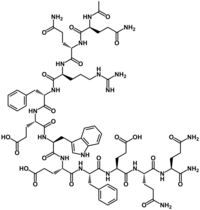
Photo from wikipedia
ObjectivesThis prospective, randomised, split-mouth, clinical trial compared the efficacy of the self-assembling peptide P11-4 to fluoride varnish in the treatment of early buccal carious lesions.Materials and methodsSubjects presenting at least… Click to show full abstract
ObjectivesThis prospective, randomised, split-mouth, clinical trial compared the efficacy of the self-assembling peptide P11-4 to fluoride varnish in the treatment of early buccal carious lesions.Materials and methodsSubjects presenting at least two clinically affected teeth were treated at D0 (day 0) and D90 with P11-4 (test) or fluoride varnish (control). At D180, fluoride varnish was applied on all study lesions. Standardised photographs were taken at D0, D30, D90, D180 and D360 and blindly morphometrically assessed. Hierarchical linear models (HLM) under allowance of confounders were used to compare the decrease in size between test and control groups. The visual analog scale (VAS) and Global Impression of Change Questionnaire (GICQ) were used as clinical assessments.ResultsOverall, 37 subjects (13–36 years) with 90 early carious lesions were included. HLM analysis showed a significant difference between test and control groups, indicating a decrease in test lesions and stabilisation of control lesions size (p = 0.001). The test lesion’s mean size (SD) relative to baseline decreased to D30 = 0.936(0.127), D90 = 0.874(0.173), D180 = 0.844(0.215) and D360 = 0.862(0.352), whereas control lesions remained stable at D30 = 1.018(0.209), D90 = 1.013(0.207), D180 = 1.029(0.235) and D360 = 1.068(0.401). The effect sizes ranged from 0.47 to 0.82.ConclusionsWithin the limits of this study, it was shown that the size of early carious lesions treated with P11-4 was significantly reduced; this result was superior to that of fluoride varnish treatment (DRKS00012941).Clinical relevanceThe self-assembling peptide P11-4 is the first caries treatment approach aiming to regenerate decayed enamel. P11-4 initiates formation of de novo hydroxyapatite in the depth of early carious lesions, adding a new advanced therapy option for preventive dentistry.
Journal Title: Clinical Oral Investigations
Year Published: 2019
Link to full text (if available)
Share on Social Media: Sign Up to like & get
recommendations!